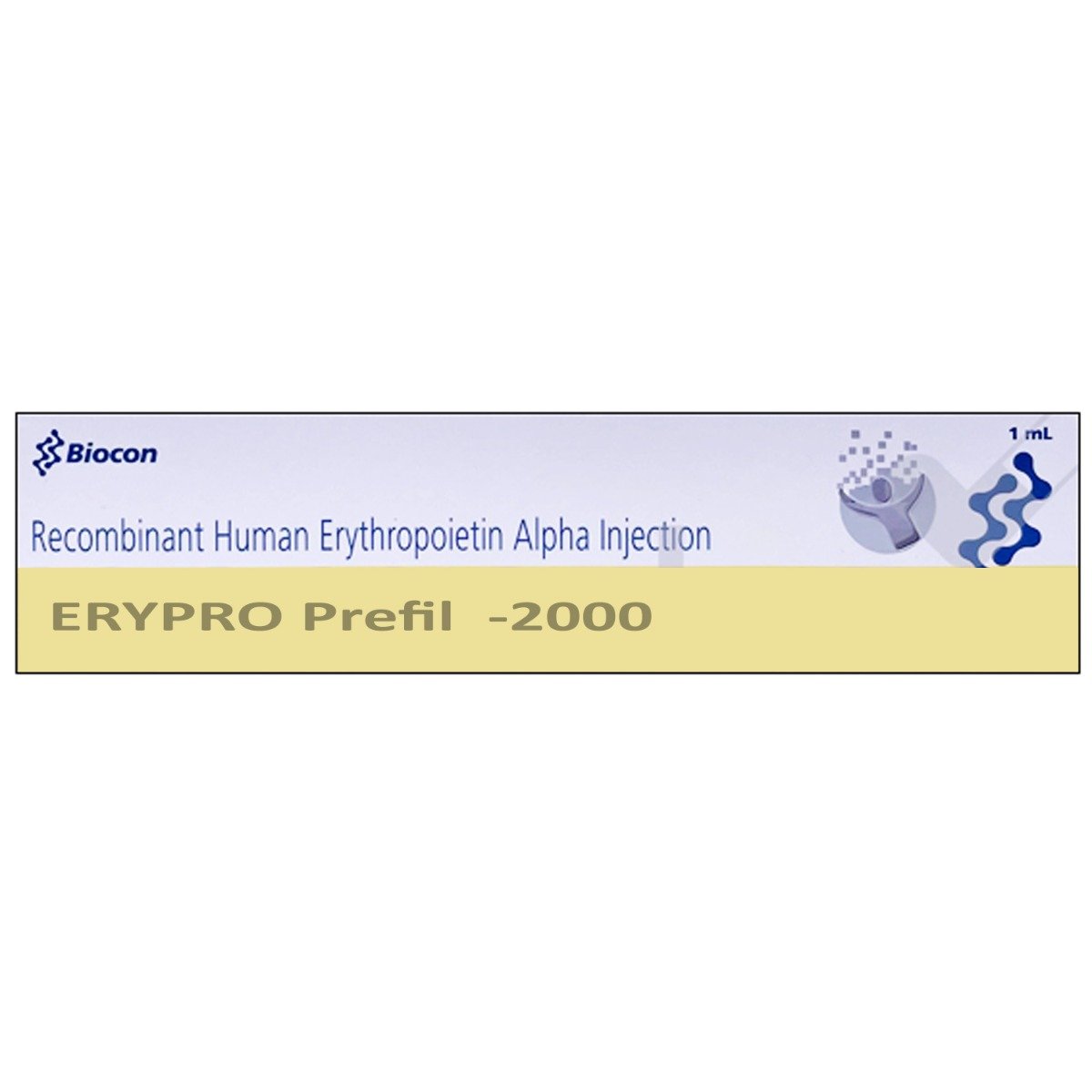Anfoe 2000IU PFS Injection 1's


MRP ₹513.5
(Inclusive of all Taxes)
₹25.7 Cashback (5%)
Provide Delivery Location
Online payment accepted
 Prescription drug
Prescription drugWhats That
Composition :
Manufacturer/Marketer :
Consume Type :
Return Policy :
Expires on or after :
About Anfoe 2000IU PFS Injection
Anfoe 2000IU PFS Injection belongs to the group of hormones used in the treatment of chronic anaemia and anaemic states seen in kidney disease, cancers, patients on chemotherapy, bone marrow disorders and in those due to undergo major bone surgery. Anaemia refers to low blood counts due to a deficiency of blood component haemoglobin, resulting in a reduced oxygen-carrying capacity of the blood.
Anfoe 2000IU PFS Injection contains Recombinant Human Erythropoietin Alfa that works by stimulating the bone marrow to produce more red blood cells, thereby correcting any low blood counts and anaemia.
In some cases, Anfoe 2000IU PFS Injection may cause certain common side effects such as vomiting, diarrhoea, fever, and nasal congestion. Most of these side effects do not require medical attention and will resolve gradually over time. However, you are advised to talk to your doctor if you experience these side effects consistently.
Please inform the doctor of your detailed medical history including hypertension, heart disease, heart attack, stroke, epilepsy, cancer, liver disease, thromboembolism, porphyria and/or pure red cell aplasia (where the bone marrow cannot produce enough RBC’s). Consult your doctor before taking Anfoe 2000IU PFS Injection during pregnancy and nursing.
Uses of Anfoe 2000IU PFS Injection
Directions for Use
Medicinal Benefits
Anfoe 2000IU PFS Injection is a blood hormone. It contains Recombinant Human Erythropoietin Alfa used to treat anaemia caused by chronic diseases and anaemia related to kidney disease, cancers, bone marrow disorders, chemotherapy, children and adults on dialysis, and in those due to undergo major bone surgery. Anfoe 2000IU PFS Injection stimulates the bone marrow to produce more red blood cells. In addition, it also corrects any dysregulated erythropoiesis (RBC formation) and remedies the formation of any defunct precursors of RBC’s, paving the way for healthy red blood cell production. Clinically, Anfoe 2000IU PFS Injection causes a direct increase in haemoglobin values and reduces the rates and requirement of blood transfusion.
Storage
- Inform your doctor about the nausea and discuss possible alternatives to the medication or adjustments to the dosage.
- Divide your daily food intake into smaller, more frequent meals to reduce nausea.
- Opt for bland, easily digestible foods like crackers, toast, plain rice, bananas, and applesauce.
- Avoid certain foods that can trigger nausea, such as fatty, greasy, spicy, and smelly foods.
- Drink plenty of fluids, such as water, clear broth, or electrolyte-rich beverages like coconut water or sports drinks.
- Use ginger (tea, ale, or candies) to help relieve nausea.
- Get adequate rest and also avoid strenuous activities that can worsen nausea.
- Talk to your doctor about taking anti-nausea medication if your nausea is severe.
- Record when your nausea occurs, what triggers it, and what provides relief to help you identify patterns and manage your symptoms more effectively.
- Preventing Vomiting (Before it Happens)
- Take medication exactly as prescribed by your doctor. This can help minimize side effects, including vomiting.
- Having a small meal before taking your medication can help reduce nausea and vomiting.
- Talk to your doctor about taking anti-nausea medication along with your prescribed medication.
- Managing Vomiting (If it Happens)
- Try taking ginger in the form of tea, ale, or candy to help alleviate nausea and vomiting.
- What to Do if Vomiting Persists
- Consult your doctor if vomiting continues or worsens, consult the doctor for guidance on adjusting your medication or additional treatment.
- Inform your doctor immediately if you experience a fever after starting a new medication.
- Your doctor may adjust your medication regimen or dosage as needed to minimize fever symptoms.
- Monitor your body temperature to monitor fever progression.
- Drink plenty of fluids, such as water or electrolyte-rich beverages, to help your body regulate temperature.
- Get plenty of rest and engage in relaxation techniques, such as deep breathing or meditation, to help manage fever symptoms.
- Under the guidance of your doctor, consider taking medication, such as acetaminophen or ibuprofen, to help reduce fever.
- If your fever is extremely high (over 103°F), or if you experience severe symptoms such as confusion, seizures, or difficulty breathing, seek immediate medical attention.
- Hydrate your body: Drink enough water to prevent dehydration and headaches.
- Calm Your Mind: Deep breathing and meditation can help you relax and relieve stress.
- Rest and Recharge: Sleep for 7-8 hours to reduce headache triggers.
- Take rest: lie down in a quiet, dark environment.
- Cold or warm compresses can help reduce tension.
- Stay Upright: Maintain good posture to keep symptoms from getting worse.
- To treat headaches naturally, try acupuncture or massage therapy.
- Over-the-counter pain relievers include acetaminophen and ibuprofen.
- Prescription Assistance: Speak with your doctor about more substantial drug alternatives.
- Severe Headaches: Seek emergency medical assistance for sudden, severe headaches.
- Frequent Headaches: If you get reoccurring headaches, consult your doctor.
- Headaches with Symptoms: Seek medical attention if your headaches include fever, disorientation, or weakness.
- Inform Your Doctor: Notify your doctor immediately about your diarrhoea symptoms. This allows them to adjust your medication or provide guidance on managing side effects.
- Stay Hydrated: Drink plenty of fluids to replace lost water and electrolytes. Choose water, clear broth, and electrolyte-rich drinks. Avoid carbonated or caffeinated beverages to effectively rehydrate your body.
- Follow a Bland Diet: Eat easy-to-digest foods to help firm up your stool and settle your stomach. Try incorporating bananas, rice, applesauce, toast, plain crackers, and boiled vegetables into your diet.
- Avoid Trigger Foods: Steer clear of foods that can worsen diarrhoea, such as spicy, fatty, or greasy foods, high-fibre foods, and dairy products (especially if you're lactose intolerant).
- Practice Good Hygiene: Maintain good hygiene to prevent the spread of infection. To stay healthy, wash your hands frequently, clean and disinfect surfaces regularly, and avoid exchanging personal belongings with others.
- Take Anti-Diarrheal Medications: If your doctor advises, anti-diarrheal medications such as loperamide might help manage diarrhoea symptoms. Always follow your doctor's directions.
- Keep track of your diarrhoea symptoms. If they don't get better or worse or are accompanied by severe stomach pain, blood, or dehydration signs (like extreme thirst or dark urine), seek medical help.
- Report to Your Doctor: Inform your doctor about the muscle pain, as they may need to adjust your medication.
- Stretch Regularly: Gentle stretching can help relieve muscle pain and stiffness.
- Stay Hydrated: Adequate water intake supports muscle health by removing harmful substances and maintaining proper muscle function.
- Warm or Cold Compresses: Apply cold or warm compresses to the affected area to reduce pain and inflammation.
- Rest and Relaxation: Adequate rest helps alleviate muscle strain, while relaxation techniques like deep breathing and meditation can soothe muscle tightness, calm the mind, and promote relief from discomfort.
- Gentle Exercise: Participate in low-impact activities, such as yoga or short walks, to improve flexibility, reduce muscle tension, and alleviate discomfort.
- Consult a physician: If your symptoms don't improve or get worse, go to the doctor for help and guidance.
- Weight loss without physical activity needs immediate medical attention.
- Get a physical examination and blood tests done to identify factors causing weight loss that could be related to metabolism and thyroid function.
- Avoid smoking and alcohol intake as it can alter your liver condition and increase your weight loss.
- Practice meditation and yoga to avoid anxiety, which can be one of the leading causes of weight loss.
- Talk to your dietician and consume food which can maintain ideal weight.
Drug Warnings
Inform the doctor in case of an allergy to any of its components. Proceed with caution in case of a latex allergy. Please inform the doctor of your detailed medical history including hypertension, heart disease, myocardial infarction, stroke, epilepsy, head and neck cancers, liver disease, thromboembolism, porphyria and/or pure red cell aplasia (where the bone marrow cannot produce enough RBC’s). Inform your doctor of any medicines you may be taking especially if you are on any immunosuppressants, blood thinners or blood stimulants. Please consult your doctor before taking Anfoe 2000IU PFS Injection during pregnancy and nursing.
Drug-Drug Interactions
Drug-Drug Interactions
Login/Sign Up
Pomalidomide can cause serious blood clots and taking it alongside Anfoe 2000IU PFS Injection may enhance the risk.
How to manage the interaction:
Co-administration of Anfoe 2000IU PFS Injection with Pomalidomide can result in an interaction, but it can be taken if a doctor has advised it. However, if you experience chest pain, breathing difficulty, coughing up blood, sudden loss of vision, pain, redness or swelling in an arm or leg, and numbness or weakness on one side of the body, consult the doctor immediately. Do not discontinue any medications without a doctor's advice.
Taking thalidomide with Anfoe 2000IU PFS Injection may increase the risk or severity of thromboembolism(a circulating blood clot that gets stuck and causes an obstruction).
How to manage the interaction:
Although taking Anfoe 2000IU PFS Injection and thalidomide together can possibly result in an interaction, it can be taken if your doctor has prescribed it. However, consult the doctor immediately if you experience symptoms such as chest pain, shortness of breath, difficulty breathing, coughing up blood, sudden loss of vision, pain, redness or swelling in an arm or leg, and numbness or weakness on one side of the body. Do not discontinue any medications without consulting a doctor.
Combining Anfoe 2000IU PFS Injection with Lenalidomide can increase the risk of Thrombosis(formation of a blood clot ).
How to manage the interaction:
Although there is an interaction between Anfoe 2000IU PFS Injection and Lenalidomide, it can be taken if prescribed by a doctor. Do not discontinue any medications without consulting a doctor.
Carfilzomib can cause serious blood clots and taking it alongside Anfoe 2000IU PFS Injection may enhance the risk.
How to manage the interaction:
Co-administration of Anfoe 2000IU PFS Injection with Carfilzomib can result in an interaction, but it can be taken if a doctor has advised it. However, if you experience chest pain, breathing difficulty, coughing up blood, sudden loss of vision, pain, redness or swelling in an arm or leg, and numbness or weakness on one side of the body, consult the doctor immediately. Do not discontinue any medications without consulting a doctor.
Drug-Food Interactions
Drug-Food Interactions
Login/Sign Up
Diet & Lifestyle Advise
- As nausea and vomiting may occur with the use of Anfoe 2000IU PFS Injection, make sure to take it on light, small meals.
- Load up on red fruits and vegetables like apples, pomegranate, dry fruits, beans and nuts to promote blood production.
- Avoid caffeine and alcohol as these can precipitate bleeding.
- Take care of your mental health. Stress is a huge factor that can cause excessive bleeding. Make sure you meditate in the morning daily.
- Yoga has also proven very effective in preventing excessive blood loss. The butterfly pose is one of the best poses for treating heavy periods.
- Make sure you drink a lot of water and keep yourself hydrated. Fluid intake helps flush out toxins.
Side Effects of Anfoe 2000IU PFS Injection
- Diarrhoea
- Vomiting
- Stomach upset
- Fever
- Nasal congestion
Habit Forming
Therapeutic Class
All Substitutes & Brand Comparisons
RX
Out of StockZYROP 2000IU VIAL INJECTION
Zydus Healthcare Ltd
₹633.5
(₹285.08/ 1ml)
41% CHEAPERRX
Out of StockErypro Prefil 2000IU Injection 1 ml
Biocon Ltd
₹485
(₹436.5/ 1ml)
10% CHEAPERRX
RELIPOIETIN 2000IU INJECTION
Reliance Formulation Pvt Ltd
₹576.5
(₹518.9 per unit)
6% COSTLIER
Product Substitutes
Drug-Diseases Interactions
Drug-Diseases Interactions
Login/Sign Up
FAQs
Anfoe 2000IU PFS Injection works by stimulating the bone marrow to produce healthy red blood cells (RBC’s) and thus enhances blood production.
Consult your doctor before taking iron supplements along with Anfoe 2000IU PFS Injection as they might increase the effectiveness of Anfoe 2000IU PFS Injection when taken together.
Anfoe 2000IU PFS Injection might affect other treatments or tests. Therefore, inform the doctor/lab assistant that you are taking Anfoe 2000IU PFS Injection.
Not commonly. However, cases of Steven Johnson’s syndrome and Toxic Epidermal Necrosis (TEN), have been reported in rare instances. Consult your doctor immediately if you notice symptoms such as reddish-circular patches, skin peeling, fever, flu, ulcers of throat, mouth, nose, eyes or genitals.
Anfoe 2000IU PFS Injection may cause blood clots (deep vein thrombosis and embolism). Consult your doctor if you experience symptoms such as breathlessness, chest pain, painful swelling and redness in the legs.
Drug-Drug Interactions Checker List
- CYCLOSPORINE
- WARFARIN
- COUMADIN
- THALIDOMIDE
- LENALIDOMIDE
- RAMIPRIL
- POMALIDOMIDE
- LISINOPRIL
- CARFILZOMIB
Special Advise
- Anfoe 2000IU PFS Injection should never be given intramuscularly.
- Do not self-inject before proper training.
- Exercise caution in case of a history of allergic disorders or a known allergy to latex, or any of the components of Anfoe 2000IU PFS Injection.
- Please inform the doctor immediately if you notice any anaphylaxis (allergy, skin changes, difficulty in breathing, anxiety, confusion, dizziness etc) post-injection.
- Your doctor may advise blood tests regularly to check your need and tolerance of Anfoe 2000IU PFS Injection.
Disease/Condition Glossary
Anaemia: Anaemia is a condition in which there is reduced or compromised production of red blood cells, hampering the oxygen-carrying capacity of blood. This results in reduced oxygen reaching the vital tissues of organs, leading to symptoms like lethargy, weakness, shortness of breath, paleness, mood changes, neuropathy etc.

Have a query?
Buy best Hematopoietic System products by
Intas Pharmaceuticals Ltd
Zydus Cadila
Biocon Ltd
Cipla Ltd
Dr Reddy's Laboratories Ltd
Emcure Pharmaceuticals Ltd
Wockhardt Ltd
Lupin Ltd
RPG Life Sciences Ltd
Anthem Bio Pharma
Johnson & Johnson Pvt Ltd
Zydus Healthcare Ltd
La Renon Healthcare Pvt Ltd
Panacea Biotec Ltd
Alniche Life Sciences Pvt Ltd
Micro Labs Ltd
Reliance Formulation Pvt Ltd
Torrent Pharmaceuticals Ltd
Biokindle Lifesciences Pvt Ltd
Bioniche Life Sciences Inc
Hetero Drugs Ltd
Hospimax Healthcare Pvt Ltd
Merynova Life Sciences India Pvt Ltd
Msn Laboratories Pvt Ltd
Neon Laboratories Ltd
Rene Lifescience
Septalyst Lifesciences Pvt Ltd
Serum Institute Of India Pvt Ltd
Zuventus Healthcare Ltd
Abbott India Ltd
Alkem Laboratories Ltd
Axiommax Oncology Pvt Ltd
Cadila Healthcare Ltd
Fresenius Kabi India Pvt Ltd
Lg Life Sciences India Pvt Ltd
Natco Pharma Ltd
Novartis India Ltd
Plasoron Biotech Pvt Ltd
Sanzyme Pvt Ltd
United Biotech Pvt Ltd
Aar Ess Remedies Pvt Ltd
Abl Biotechnologies Ltd
Adonis Laboratories Pvt Ltd
Amzenex Healthcare Pvt Ltd
Balint Pharmaceuticals
Biokind Life Science
Bioviz Technologies Pvt Ltd
Calren Care Lifesciences Pvt Ltd
Celera Pharma Pvt Ltd
Celestial Biologicals Ltd
Celon Laboratories Pvt Ltd
Concord Biotech Ltd
Concord Laboratories Pvt Ltd
Core Claris Lifesciences Ltd
Crossland
Del Trade International Pvt Ltd
Genix Lifescience Pvt Ltd
Gennova Biopharmaceuticals Ltd
GlaxoSmithKline Pharmaceuticals Ltd
Gufic Bioscience Ltd
Innovcare Life Sciences Pvt Ltd
J B Chemicals & Pharmaceuticals Ltd
Levin Life Sciences Pvt Ltd
Lifeline Systems Pvt Ltd
Myren Life Science India Pvt Ltd
Piramal Enterprises Ltd
Ranbaxy Laboratories Ltd
Renakart Life Sciences Pvt Ltd
Roche Diagnostics India Pvt Ltd
Sanofi India Ltd
Sarabhai Chemicals (India) Pvt Ltd
Sayre Therapeutics Pvt Ltd
Swarion Life Sciences Pvt Ltd
Vhb Life Sciences Inc
Zenlabs Ethica Ltd
Alcohol
Caution
There is not enough literature to explain the effects of alcohol. Consult your doctor if you have any concerns.
Pregnancy
Caution
There is not enough literature to explain the effects of Anfoe 2000IU PFS Injection on pregnancy. Anfoe 2000IU PFS Injection may be used in pregnancy but it is important to consult your doctor.
Breast Feeding
Caution
There is not enough literature to explain the effects of Anfoe 2000IU PFS Injection on breastfeeding mothers. Anfoe 2000IU PFS Injection may be used in breastfeeding but it is important to consult your doctor.
Driving
Caution
There is not enough literature to explain the effects of Anfoe 2000IU PFS Injection on driving. Do not drive if you experience any side-effects that alter your thinking ability or concentration.
Liver
Caution
Exercise caution before using Anfoe 2000IU PFS Injection in case of liver disease. Consult your doctor if you have any concerns.
Kidney
Caution
Exercise caution before using Anfoe 2000IU PFS Injection in case of kidney disease. Consult your doctor if you have any concerns.
Children
Safe if prescribed
Anfoe 2000IU PFS Injection can be used in children in prescribed paediatric doses.






